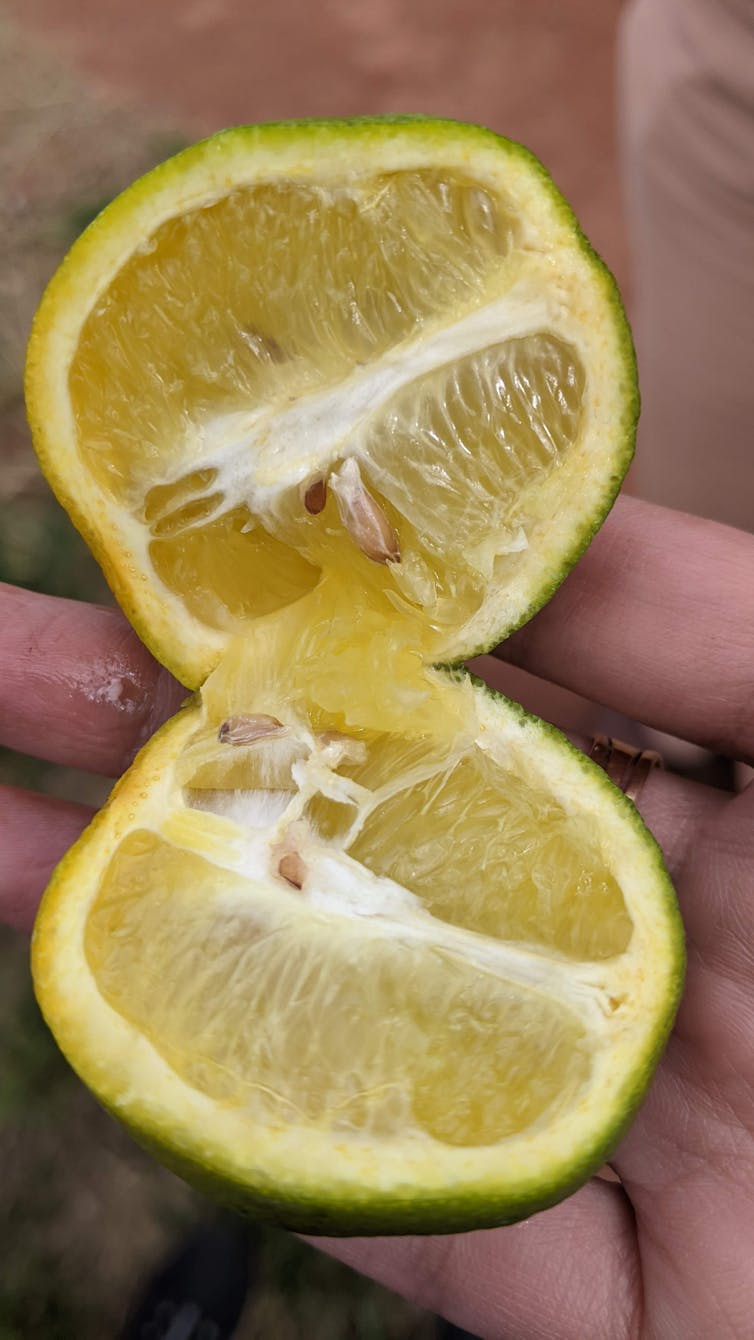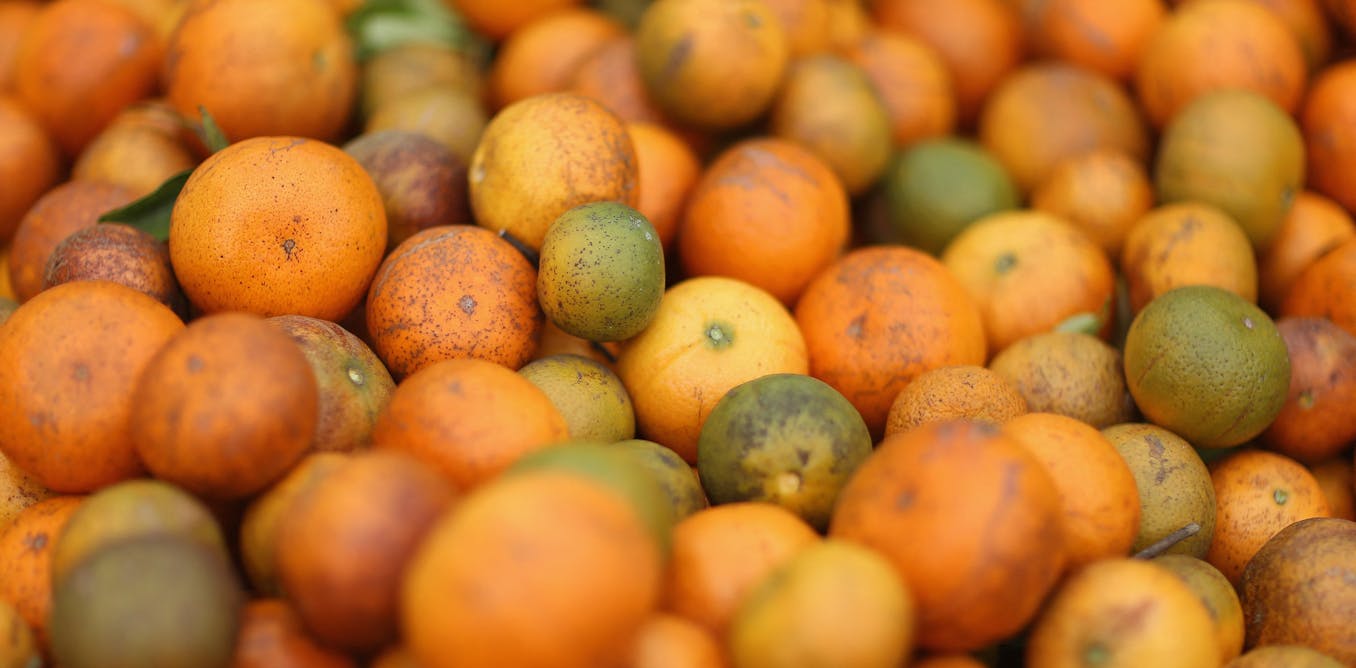If world agricultural authorities don’t get their act together soon enough, your morning orange juice may disappear from the supermarket shelves – for good.
This is how critical the situation has become in the citrus growing world. In the past decades, a disease called Huanglongbing (HLB), also known as “citrus greening” disease, has been devastating orchards in Asia, the Americas and several African countries. Although world production has increased in recent years thanks to strong market demand and new plantings, the disease’s relentless expansion is leading growers to fear the worst.
The economic impacts are dramatic in some countries. In Brazil, production has fallen by more than 20%, 60% in Guadeloupe and and plummeted by more than 90% in Florida.
Florida, a well-known producer of oranges, saw thousands of jobs in the citrus sector disappear. Drastic quarantine and management measures have been put in place everywhere. The price of orange juice has doubled in the space of a year, with manufacturers now struggling to get their hands on fruits.
The disease is caused by a bacterium of the genus Candidatus Liberibacter, which parasitises the sap-conducting vessels, the phloem. Faced with the bacterium, the trees react by producing a sugar known as callose, which piles up in the vessels and chokes them off, just like in a thrombosis. The photosynthesis products SEE synthesised in the leaves are then no longer distributed throughout the tree.
Following a long asymptomatic phase, internal damage is revealed in the form of yellow mottling on the leaves. The fruit becomes deformed, abnormally coloured and more bitter, making it impossible to sell. Twigs and then branches die back. These symptoms start on one branch before spreading to the whole tree. After a few years, clogged up vessels inevitably cause the trees to die.
Gianrigo Marletta/AFP
A bacterium transmitted by insects
The bacterium is transmitted by two insects of the psyllid family. Measuring between 2 and 5 millimetres, these small winged insects, like aphids, feed themselves by inserting long their skinny tubes called rostrum into plants to suck the sap. When they feed on very young citrus shoots carrying the HLB disease, they can pick up the bacterium, which then grows in them and is passed on to other trees, in the same way as mosquitoes transmit the dengue or chikungunya viruses. These two psyllid species are quite specific to citrus and related species such as the jasmine orange (Murraya paniculata), often used as an ornamental plant.
Psyllids are extremely effective at transmitting the bacterium. A single bite can be enough to transmit the disease. The Asian psyllid (Diaphorina citri) of tropical and subtropical origin has so far been observed in Asia, South America, the Caribbean, Florida and California. The African psyllid (Trioza erytreae) is better adapted to the cool conditions of certain African plateaus.

Fourni par l’auteur
At present, of the world’s major citrus-growing areas, only the Mediterranean basin and Australia are free of the disease. However, the African psyllid, even though it does not carry the disease, has already been well established in Spain and Portugal since 2014 and 2015 respectively. The Asian psyllid, which is considered to be the most efficient vector for transmitting the bacterium, was identified in Israel in 2021. More recently still, in the summer of 2023, this same insect was identified for the first time in Europe in Cyprus. It is suspected that these long-distance movements could be linked to trade in citrus plants or the transport of ornamental plants by travellers. Warmer temperatures associated with climate change could also be favourable to the adaptation of D. citri throughout the Mediterranean basin.
Billions of dollars lost
In Florida, citrus trees have been devastated in the space of twenty years and orange production has fallen by more than 60%. The Florida orange juice industry has lost more than 3 billion dollars and almost 50% of associated jobs. Add to this the hurricanes of the past years, which have exacerbated the problem by causing fruits to fall from trees already weakened by the disease. As research has no immediate solution to offer, some believe that the Florida citrus industry is over, while the other southern states of the United States are also under threat. Despite enormous preventive efforts, the disease is progressing in California.


In all, billions of dollars have been invested over the last two decades to combat the disease worldwide, but no lasting solution has been found.
In Brazil, in the state of São Paulo, where the disease has been present since 2004, the uprooting of infected trees and the massive use of pesticides ̶ up to more than 46 treatments per year ̶ against psyllid populations, has made it possible to restrict the infection rate of trees to around 20% over the last two decades. However, in recent months, the infection rate has risen to almost 38% in medium-sized farms, suggesting the emergence of pesticide resistance in psyllids and a deterioration in the control of the disease’s vection. This situation is leading investors to plant in areas where psyllids aren’t present, or present only to a limited extent, such as the state of Minas Gerais.
Very active research
In the Mediterranean basin, the biggest priority is to limit psyllid populations, in particular through biological control. Portugal and Spain are currently carrying out successful mass releases of psyllid parasitoids, small insects that lay their eggs in psyllids and whose larvae then develop at their expense, devouring them from the inside. The plan is to also follow that policy in Cyprus.
Scientists will also be looking to stave off the bacterium by biomonitoring the area through regularly sampling throughout the Mediterranean region. In the event of positive results, this should lead to the immediate uprooting of infected trees in order to eradicate sources of contamination.
Finally, it is crucial to inform not only the citrus-growing sector, but also the general public, of the risks involved in moving plants, since the importation and use of grafts from infected territories to non-infected areas is the main source of new outbreaks of the disease. The EU has already taken the measure of the problem by categorising HLB bacteria and their psyllid vectors as priority quarantine organisms, requiring Member States to draw up appropriate surveillance and contingency plans. In France, the departments in charge of surveillance and the research community have deployed dedicated unit within the National Platform of Epidemiological Surveillance in Plant Health as well as several action-based research projects.
All cultivated citrus fruits are vulnerable to HLB, and research into resistant varieties and rootstocks is now a key area of research with a view to developing sustainable production systems. Recent research suggests that certain genotypes related to cultivated citrus within the Aurantioideae, such as the caviar lemon, may be hardier. It is therefore this type of variety that the French Agricultural Research Centre for International Development (CIRAD) and its partners are studying to understand the biological traits governing interactions between the bacterium and citrus plants.
This involves developing populations of hybrids between resistant and vulnerable individuals and gauge their resistance to the disease. The genetic and genomic studies carried out on this plant material should enable us to identify the genes associated with resistance mechanisms. Ultimately, it will then be possible, through new crosses between pre-selected genotypes or biotechnological approaches, to propose rootstocks and varieties that are resistant to the disease, paving the way for citrus growing that no longer requires the massive use of pesticides in orchards.



